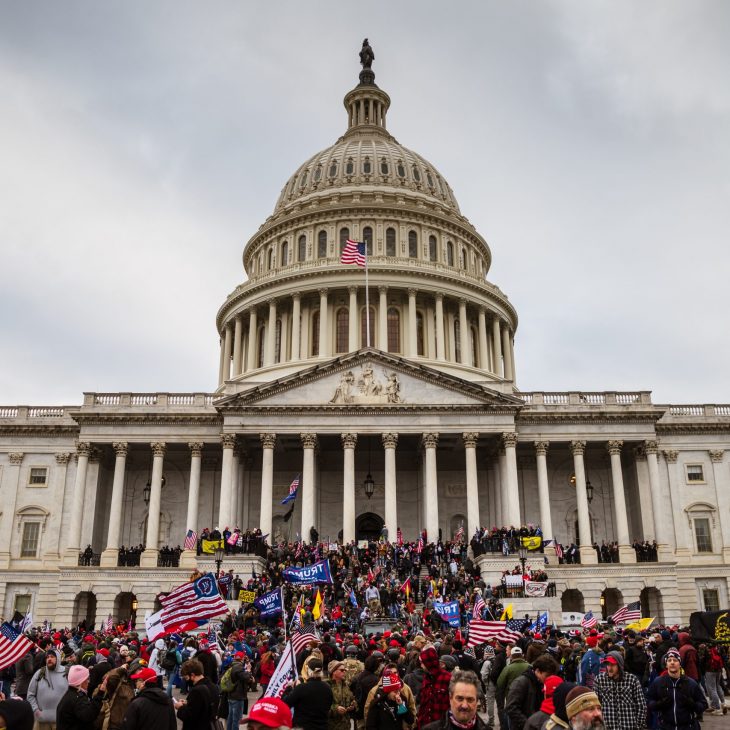How January 6 Changed My Views on Teaching Religions in Public Schools
November 18, 2022

On January 6, 2021, our school district had a virtual learning day.
After an exhausting morning of trying to engage and teach eight- and nine-year-olds over Zoom, I decided to turn on the news while I ate my lunch. I watched in horror as the Capitol building was breached. I did my best to continue teaching that afternoon, but I just couldn’t shake the images I had seen on the news. That evening and for several days after, I tuned into the coverage as I tried to make sense of what happened.
Of all of the images of the insurrection, one that stuck with me the most was one of a man wearing a black sweatshirt. Scrawled across the front of his sweatshirt were the words “Camp Auschwitz” and “Work Brings Freedom” – a rough translation of Arbeit macht frei. These words are often found at the entrance to Auschwitz and other Nazi concentration camps.
As an American Jew, the sight of a man wearing a sweatshirt that glorified the Holocaust standing in front of the U.S. Capitol building horrified me. I thought back to what I had learned at the Interfaith Leadership Summit in college. When a person becomes acquainted with someone of another faith, it challenges their misconceptions or negative perceptions about people of that faith. Ignorance begets hatred, and hatred begets violence. In the absence of ignorance, hatred and violence decline.
Has this man ever even met a Jew? I thought. Likely not. Just 2.4 percent of the U.S. population is Jewish. In many communities across the United States, that number is much smaller, or no Jewish community is present. What then, can be done about ignorance and religious violence towards religious minorities?
Religious Violence is Increasing in the United States
In the days after the attack on the capitol building, Americans learned that members of a number of militant white supremacist groups were involved in the insurrection. Many of those involved subscribed to the anti-semitic QAnon conspiracy theories about Jewish elites and “globalists” – a pejorative used in far-right movements to refer to Jewish people.
The insurrection is just one incident of violence inflamed by religious bigotry. Religious violence is increasing. According to the Anti-Defamation League, “Antisemitic incidents reached an all-time high in the United States in 2021, with a total of 2,717 incidents of assault, harassment and vandalism reported to the Anti-Defamation League. This represents the highest number of incidents on record since the Anti-Defamation League began tracking antisemitic incidents in 1979 – an average of more than seven incidents per day and a 34 percent increase year over year.” Per the American Civil Liberties Union, “anti-Muslim sentiment has spiked” in recent years.
Religious bigotry is deadly. In 2012, a white supremacist shot and killed 6 people at a Sikh Gurdwara in Wisconsin. In 2018, a man who had espoused antisemitic ideas shot and killed 8 people at a synagogue in Pennsylvania.
Teachers, Parents: A Call to Action
Before January 6th, I was steadfast in my belief that it was inappropriate to talk about religion or religious ideas at public schools like the one I teach at. While I still firmly believe that preaching religious ideas and celebrating religious holidays have no place in public schools, I am equally unyielding in my conviction that we need to talk about religions in the classroom.
The internet and social media are rife with bigotry. Hate groups use social media platforms to disseminate their ideology to a broad audience. Consequently, those who spend the most time online – children, adolescents, and young adults – are likely to encounter their propaganda.
Limiting and monitoring children’s internet usage can help but does not solve the problem at hand. Eventually these children will become young adults who, no longer under the surveillance of their parents and teachers, will then encounter hate speech and propaganda from hate groups. What will they do then? The solution, as I see it, is two-fold.
First, we must teach young people media literacy, so that they can identify reliable sources and evaluate the messages they encounter so that they learn to recognize disinformation and logical fallacies and approach unsubstantiated claims they encounter with skepticism, while remaining open-minded to claims based in fact.
We also need to present young people with powerful counternarratives about religious minorities before they encounter misinformation.
It is likely that our children will encounter hate speech about religious minorities at some point in their life. As teachers and parents, we have a responsibility to prepare our children and students so that when they do encounter hate speech, they know better. It is imperative that we do not ignore this responsibility.
We cannot know if the man in front of the Capitol building ever met a Jew. I cannot help but think, however, that if he did, he could not have worn that sweatshirt. Perhaps he would not have been on the Capitol steps at all on that tragic day.
We cannot guarantee that all of our children meet a Jew, or a Muslim, or a Sikh. But we can expose our students to stories featuring positive depictions of Jews, Muslims, and Sikhs. We can educate ourselves, and then teach our children about people of multiple faiths, what they believe, and what they don’t. And when hate happens, we can talk with our children about it, and why it is wrong.
Ryan Lutker is a third-grade teacher at a public school in St. Louis, Missouri. He is an alumnus of the Interfaith Leadership Institute.
Share
Related Articles
American Civic Life
American Civic Life
American Civic Life
Seven Religion Reporters Share Advice for Reporting in Interfaith America



